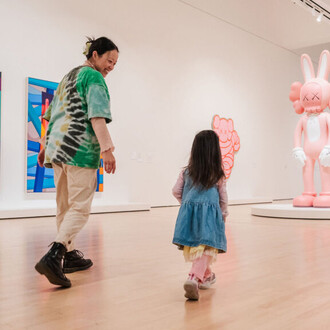Rather than memento mori - reminders of the inevitability of death - these works are memento vivere: literally exhortations to remember to live. With their bright palette and lanky grace, they are signals asserting that the artist is still here, still standing, still alive - and so are we.
(Maria Porges)
At the time of writing, there was no way of knowing how à propos Maria Porges’ words would be. Just over a year into the uphill battle against brain cancer and Kirk Stoller is still very much here, still alive, surrounded and supported by a vibrant panoply of colors.
CLUB KIRK is a group exhibition curated by Kirk Stoller and Romer Young Gallery to reflect the profound support, friendship, and sensibility that artists share in a community. Featuring the work of Kirk Stoller, Elise Ferguson, Pamela Jorden, Christoph Roßner, Erik Scollon, and Nancy White, CLUB KIRK uses the exhibition space as both support and backdrop for the work. As with so many of Stoller’s pieces, nothing specific is revealed about how the parts come together and stay together. Here again, viewers are invited to create their own relationship with each decidedly non-representational piece.
Stoller’s work has long been engaged in the discourse between object and metaphorical emotional states. He uses line to create volume; wandering forms to mimic the open-ended, unpredictable pathways in life and the intertwining of chance, choice and fate; and color as emotional implicators to carry personal, biographical meaning. Yellow, for example, recalls his childhood home and often appears at the base or foundation of a work. Pink often appears as a reference to his sisters. It is possible that many of us have appeared as splashes of color on scraps of scavenged wood, precariously placed in sculptures that allude to the temporality of life. In all their seemingly overt instability, Stoller always engineers his sculptures to defy expectation and reveal an underlying stability, inner strength and enduring core. They are steadfast and enduring. Like the individual bits and pieces of materials foraged and carried from various walks of his life, Kirk also brings people together, joining their histories with his own in an uncertain yet warily optimistic present.’ (MP)
Of his earlier work, Kirk wrote: I Hope I Don’t Fall Down reflects the difficulty of remaining upright against the rapid onslaught of change we confront in our daily lives: personal, societal, economic, technical. It is overwhelming, and indeed at times can seem impossible to withstand. That’s when we lean on the pressure points for balance and, by virtue of our weight and stubbornness, we hope to remain standing so as to face another onslaught. This, in turn, may require another adjustment, a shift in balance, or new points of connection.
(Kirk Stoller from 2011)
















